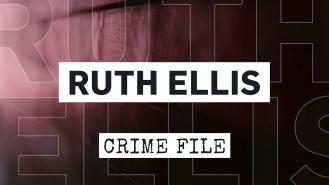
Ruth Ellis was born Ruth Neilson in the coastal town of Rhyl, Wales on 9 October 1927. The original family name was Hornby but her father, a cellist from Manchester, used the stage name Arthur Neilson. Much of his work was playing music on Atlantic cruise liners. Her mother, Elisaberta, was half French, half Belgian and had fled to the UK during the World War I German invasion of Belgium.
The shortsighted, bespectacled Ellis was one of five children who were raised as strict Catholics. As a young girl, Ellis loved clothes and aspired to make something out of her life. At the height of the Blitz (the sustained bombing of the United Kingdom by Nazi Germany between 7 September 1940 and 16 May 1941), the family moved to London in 1941. Ellis was 14 years old and left school to begin working as a waitress. By 16, she was starting to make the most of her looks, dyeing her dark hair blonde, and was determined to live life to the fullest.
At age 17, she had a brief affair with a French-Canadian soldier, named Clare, who was a married man. She fell pregnant soon after Christmas 1944 and gave birth to a son, Clare Andrea, whom everyone called Andy, on 15 September 1945. Clare continued to pay maintenance and visit Ellis and her son, who were living with her parents until, abruptly, he returned to his family in Canada, sending her a bunch of red roses and a letter informing her he was gone.
Ellis was distraught and felt abandoned. Her faith in men had been badly shaken, and she would never see him again. Having to support a young son on her own, Ellis found work in factories and had various clerical jobs. These were not very well paid and she decided to try her hand at something more lucrative. She began some modelling work and then became a nightclub hostess, finally earning a significant wage.
At the age of 23, she married George Johnson Ellis on 8 November 1950. Her husband, a 41-year-old divorcée with two sons, was a dentist and had been one of her nightclub customers. Sadly, it transpired that George was an alcoholic and prone to violence when drunk. Ellis became convinced he was having an affair, her behaviour towards him becoming possessive and jealous.
The marriage quickly began to show signs of strain and when her second child, Georgina, was born in 1951, George refused to acknowledge the child as his own. Ellis could not remain in the situation any longer and the couple soon separated. Ellis went to live with her parents and returned to work as a nightclub hostess.
The Arrest
As fate would have it, Metropolitan police officer Alan Thompson was having a drink at The Magdala. He found Ellis still holding the gun and cautioned her. A few minutes later, police from the Hampstead Police Station arrived, arrested Ellis and took her into custody on 10 April 1955. David Blakely was rushed to the New End Hospital but pronounced dead on arrival.
At 11pm on 10 April 1955, witnessed by three senior CID officers, Ellis made a statement admitting to shooting Blakely. The officers present were Superintendent Leonard Crawford, Detective Chief Inspector Leslie Davies and Detective Inspector Peter Gill.
At 12.30pm on 11 April 1955, Ellis was charged with murder. She appeared briefly at Hampstead Magistrates Court on 12 April 1955, before being taken to the all-female Holloway Prison in Islington, to await her sentence of death by hanging, less than a month away, as Prisoner 9656.
The Aftermath
At the age of 27, Ellis made history when she went to the gallows at Holloway Prison on 13 July 1955, becoming the last woman to hang in England. As was customary with hangings, Ellis was buried in an unmarked grave in the Holloway Prison Cemetery.
Following extensive rebuilding of the prison in the early 1970s, all the bodies of female executions were exhumed and their remains reburied in Brookwood Cemetery. Ellis was the exception, as she was reburied at Saint Mary Churchyard in Amersham, Buckinghamshire, with her headstone bearing her birth name, Ruth Hornby.
The Ellis hanging provoked much controversy and on the day of her execution, the Daily Mirror newspaper ran a story attacking her sentence, written by columnist Cassandra, that later became famous. The general public also felt the need for their opinions to be heard and 50,000 people signed a petition to the Home Office, asking for clemency. The appeal was rejected by the Conservative Home Secretary, Major Gwilym Lloyd George. The force of public support finally won and 10 years after Ellis was hanged, the death penalty was abolished in Britain in 1965. People were starting to realise that politics played a far greater role in judicial sentencing than previously realised and that capital punishment was becoming arbitrary.
The last person to be sentenced to death in England was David Chapman in November 1965; in Wales it was Edgar Black, who was reprieved on 6 November 1963; in Scotland it was Patrick McCarran in 1964, who died in prison in 1970; and in Ireland it was William Holden in 1973, who was removed from his death row cell in May 1973.
Public opinion had it that there were various factors working against Ellis in her sentencing, including her appearance and lifestyle, the fact that she wounded a passer-by and not least, her apparent lack of remorse. It also transpired that the murder and Ellis’ arraignment occurred during the 1955 General Election campaign, which was won by the Conservatives who supported the death penalty. The new Home Secretary could not be seen to be influenced by the public furore and media debate, in granting Ellis a reprieve.
Tragedy seemed to surround the deaths of Blakely and Ellis. A few weeks after her execution, Ellis’ younger sister died suddenly at the age of 18, supposedly of a broken heart. Ellis’ husband, George, had been a heavy drinker and after sinking into the depths of alcoholism, committed suicide by hanging in 1958. Ellis’ son, Andrea, was deeply psychologically affected by what had happened and was living in a squalid bedsit when he committed suicide in 1982.
Films have been made, telling the tragic story of Ruth Ellis. These include Mike Newell’s ‘Dance with a Stranger’ (1985), starring Rupert Everett as David Blakely and Miranda Richardson as Ellis; and Adrian Shergold’s ‘The Last Hangman’ (2005) (UK title: ‘Pierrepoint’), with Mary Stockley playing Ellis. A film that bears a close resemblance to the Ellis story, about a doomed murderess, is ‘Yield to the Night’ (1956) starring Diana Dors. The film was in fact based on the 1954 Joan Henry book of the same name.
Timeline
Born: 9 October 1927 - Rhyl, Wales
Early 1941: Moved to London
15 September 1945: First child born: son Clare Andrea (Andy)
8 November 1950: Married George Ellis
1951: Second child born: daughter Georgina
1953: Met David Blakely,
The Victim
10 April 1955: Shoots David Blakely, 25
10 April 1955: Arrested: approximately 9 pm 10 April 1955 - 11 pm: made a statement admitting to shooting Blakely
11 April 1955 –12.30 pm: Charged with murder
Trial
12 April 1955: Appeared briefly at the Hampstead magistrate’s court
20 June 1955: The Old Bailey trial
Convicted: 20 June 1955
Sentenced: 20 June 1955
Died: 13 July 1955 – Hanged at Holloway Prison, London
The Crimes
Ellis worked hard and, in 1953, became the manager of a nightclub where she met David Blakely. He was a man with public school manners and expensive tastes but also a racing driver with a passion for fast cars and hard drinking. At the time of their meeting, Blakely was engaged to another woman but soon moved in with Ellis, who lived in an apartment above the nightclub. He was smitten and began proposing marriage. Ellis initially desisted, as she was still legally married to George Ellis, but eventually accepted.Blakely began to show a jealous side and spent progressively more time at the nightclub, where he could keep an eye on Ellis, who enjoyed much male attention from her customers. Blakely’s behaviour began to have an adverse effect on her earnings and his inheritance was all but depleted in the funding of his lavish lifestyle and on developing a racing car. Fuelled by frustration and alcohol, the couple began fighting over money issues and before long these fights became violent. Blakely had been keeping another mistress, which had provoked jealousy in Ellis. She then took another lover, the slightly older Desmond Cussen, who had disliked Blakely. Cussen was an RAF pilot, trained in South Africa, who flew bombers in World War II and later became an accountant.The situation was spinning out of control and on the evening of Easter Sunday, 10 April 1955, Ellis went to find Blakely at The Magdala public house in Hampstead, London. She waited outside whilst Blakely and his friend, Clive Gunnell, finished their drinks and left the pub. As they were getting into Blakely’s car, Ellis called out his name and then fired four rounds into his body. The fifth bullet, missing its mark, ricocheted off the pavement, hitting the hand of Gladys Kensington Yule, who was on her way into the pub with her banker husband. Ellis knew exactly what she was doing and made no attempt to flee the scene. Instead, she calmly turned to Gunnell and told him to call the police.
The Trial
The trial took place at The Old Bailey, London on 20 June 1955. The only question put to Ellis on the stand by Christmas Humphreys for the Prosecution was, “When you fired the gun, did you mean to kill?’. Her reply was simply, “It is obvious that when I shot him, I intended to kill him”. The jury took a mere 14 minutes to reach the conclusion of guilty as charged, for the murder of David Blakely. Ellis was held at the all-female Holloway Prison in Islington, London, to await her sentence of death by hanging, less than a month away.The fact that Ellis had obtained a gun to commit the murder was not explored in the trial and it was not until the day before she was hanged, that any mention was made of it. In a statement, Ellis claimed that her other lover, Desmond Cussen, had provided the gun and had in fact also driven her to the scene of the crime. In a strange twist, the authorities chose to ignore this statement and never followed it up.

